About the Museum
Kuboso was a cotton weaving company that was in operation for over 100 years, and flourished as one of the most successful corporations in the Senshu region. It was established by Sotaro Kubo (1863–1928) in 1886, who was then succeeded by Sotaro Kubo II (1889–1944), Tadakiyo Kubo (1900–1954), and Sotaro Kubo III (1926–1984). Throughout this extensive period, it was very active and played a major role in the development and prosperity of Izumi City. When the business closed in 1977, Sotaro Kubo III donated its art collection along with the museum building, the site it is located on, and generous funds to the city, to help with regional and cultural development. Thereafter, in October 1982, the museum was opened on the premises of the former residence of the Kubo family with the name taken from the name of the founder, Sotaro Kubo.
In 1997, the Annex was donated by Tsunehiko Kubo, the 5th generation member of the Kubo family and the honorary director of the museum. Since then, this site of approx. 16,500m² has grown to what it is today, with additional endowments, by the Kubo family or those related to the company, of a music hall, citizens’ gallery, citizens’ workshop studio, and a research institute.
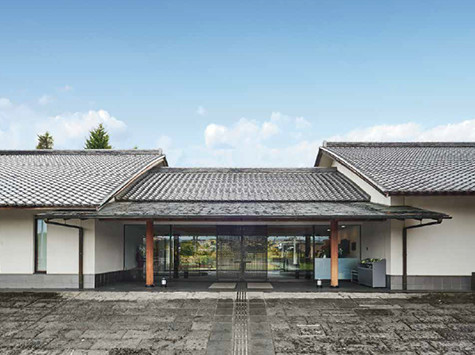
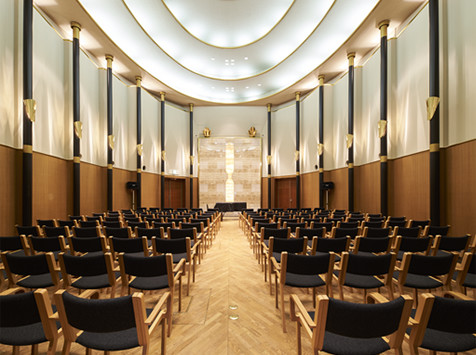
Museum Activities
Exhibitions
The museum plans and holds exhibitions on Oriental antiques primarily from Japan and China. Six exhibitions are held annually in the main building as described below. On display in the annex are works that include jade, bronzeware, and ceramics from China, as well as Western modern art by such masters as Renoir and Rodin.
-
Special Exhibitions (once a year)
Every year in Autumn, Oriental paintings, calligraphic works, and art objects are displayed on a single theme. Visitors have the chance to see masterpieces on loan from other museums in Japan and works from private collections.
-
Special Displays (once a year)
National treasures, important cultural properties, and other masterpieces from the museum are exhibited, along with featured collections.
-
Regular Exhibitions (four times a year)
Paintings, calligraphic works, and art objects from Japan and China, and other works from the museum collection are displayed on a particular theme.
Publications
-
Catalogs
Past catalogs have presented the highlights of our collections. And an exhibition catalog is issued for each special exhibition that includes figures and descriptions for the exhibited works.
-
Museum Journals
Past issues have covered research theses on art by museum curators and researchers from Japan and abroad.
-
Research Publications
Past publications have presented research results on the museum’s artwork.
Lifelong Learning
-
Izumi City-Kuboso Citizen’s Hall (Ei Hall)
Museum concerts and other performances are held at the hall.
-
Izumi City-Kuboso Citizen’s Gallery
The gallery serves as an exhibition space for the creative activities of local citizens—exhibiting paintings, photographs, ceramics, etc.
-
Izumi City-Kuboso Citizen’s Studio
Classes are offered on ceramics, painting, dyeing, and other arts.
-
Public Classes
The museum’s curators hold art appreciation classes on such themes as Japanese painting, Chinese art and Western art to allow local citizens to become more involved in the museum. The classes are announced in the Izumi City bulletin “Izumi” to gather participants.
-
Other
Digitization of the works in the museum’s collection is proceeding for the purpose of sharing the artwork via the Internet with the public. Some of these digitized works can be viewed at the Digital Museum on the top page.
Major Works
Japanese Paintings and
Calligraphic Works
Among the calligraphic works are the Heian-period Kasen Uta-Awase (A Competition comparing coupled poems by Poetic Immortals), National treasure and Tsurayuki shuka Dankan “Ishiyama-gire” by Fujiwara Sadanobu (2 Segments of anthology of Tsurayuki's poems “Ishiyama-gire” codex joined) (Important cultural property) and One of “Kumano Kaishi” by Fujiwara Norimitsu (poems composed at poetry parties during Emperor Go-Toba's journeys to Kumano) (Important cultural property). There are also several other important cultural properties (Important cultural properties) among the calligraphic works that include emaki scrolls of the Nara period and later, and the Kamakura period.
Among the painted works are scrolls that include the Ise Monogatari Emaki (Illustrated scenes from the Tales of Ise), Komakurabe Gyoko Emaki (Illustrated scenes from the “Horserace” chapter of the Eiga Monogatari), and Muromachi-period Sanno Reigen Ki (Illustrated Miraculous Tales about the Gods of Sanno Shrine) (all Important cultural properties), as well as Genji Monogatari Tekagami (An Album of Illustrated Scenes from The Tale of Genji) by Tosa Mitsuyoshi, the Shrike in barren tree by Miyamoto Musashi (all Important cultural properties). The collection includes 6,000 ukiyoe prints on a wide range of subjects, including landscapes by Hokusai and Hiroshige, as well as portraits by Utamaro and Sharaku, and warriors prints by Kuniyoshi.
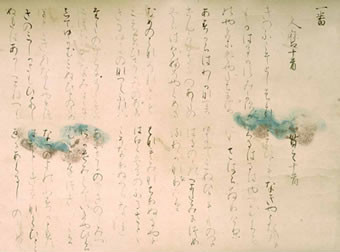
(A Competition comparing coupled poems
by Poetic Immortals), National treasure
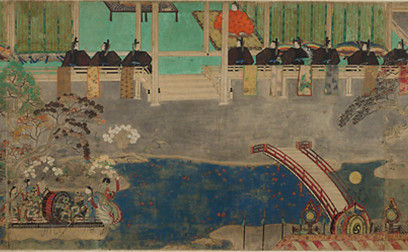
(Illustrated scenes from the “Horserace” chapter of the
Eiga Monogatari), Important cultural property
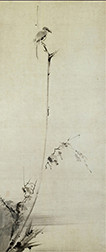
by Miyamoto Musashi,
Important cultural property
Chinese Paintings and
Calligraphic Works
There are two important cultural properties: Ju-o-kyo Zukan (Buddhist Scripture perhaps unearthed in Dunhuang) and Shōkizu (Zhong Kui). In addition, the Teiseido Collection has 411 modern art paintings donated by Dr. Hayashi Munetake in 2000, plus one of Japan’s leading collections from this period in Chinese history.
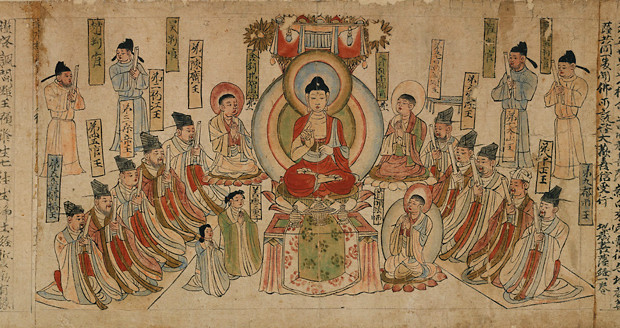
Important cultural property
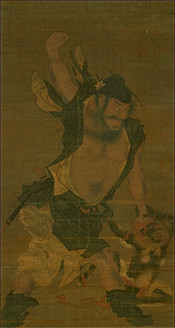
Important cultural property
Ceramics
The collection includes “Bansei”, celadon vase with phoenix handles, Longquan ware, from China’s Southern Song Dynasty (National treasure), Kizeto Ryuko Hanaire, Flower vase of ryuko (standing hourglass-shaped hand drum) shape, known as “Tabi-makura”, Ki (yellow) seto type, from Japan’s Momoyama period (Important cultural property), Teabowl, Karatsuware, known as “Sampo” (Three treasures) (Important cultural property), and Chinese and Japanese bronze mirrors from China and Japan from the First Kuboso Collection.
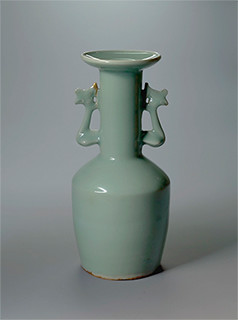
Longquan ware, known as “Bansei”,
National treasure
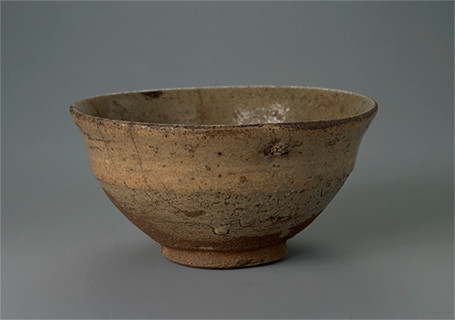
Karatsuware, known as “Sampo” (Three treasures),
Important cultural property
Metal Works
The collection includes seven important cultural properties, including Kyodo Suibyo (Holy-water ewer) (Nara period) and Kyodo Jakubigatae Koro (Incense burner with handle in shape of magpie tail) (China, Northern and Southern Dynasties). There are about 2,500 metal works in total. There are 276 bronze mirrors from Japan and China, as well as bronze mirrors from the Shang (Yin) Dynasty, which are notable works from the museum’s collection next to the emaki scrolls.
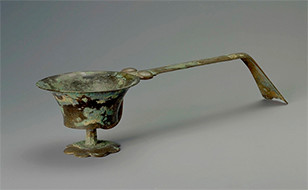
in shape of magpie tail,
Important cultural property
Other Oriental Art
In addition to the works mentioned above, others include objects from the Neolithic age to the Han dynasty, tea implements from the Ming/Qing dynasty, and ancient metal works from Western Asia.
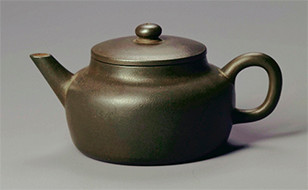
(purple clay, Qing dynasty, China)
Western Art
The collection has fifteen modern paintings and two sculptures by the likes of Monet, Renoir, Van Gogh, Picasso, and Rodin, plus antique maps of the world, including Asia, made in Europe in the 16th to 18th centuries, and Western etchings and lithographs from the 19th and 20th centuries.
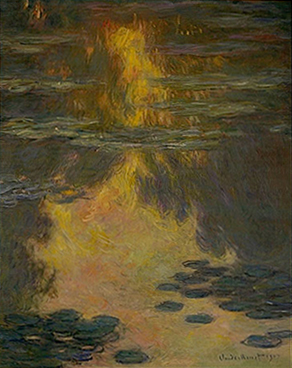
Book Collection
The collection has approximately 67,000 books and materials on Oriental art, primarily from Japan and China, and on the history, archeology, religions, and cultures of various regions related to Oriental art. The collection includes about 35,000 books formerly in the collection of preeminent Japanese historian Shigeki Kaizuka, an authority on ancient Chinese history. The Chinese-language books from this collection are held as the Shigeki Kaizuka Commemorative Library.
Our Collections
The Kuboso
Collections
The museum began with approximately 500 Oriental antiques donated by the Kubo family and Kuboso Corporation, part of the First Kuboso Collection. The museum has since expanded and now has six collections, extending to Western art, ancient maps, and ukiyoe.
-
The First Kuboso Collection
This is the collection of approximately 500 Oriental objects of art donated by the Kubo family and Kuboso Corporation with which the museum opened in 1982. They include picture scrolls, sumie paintings, ancient writings, calligraphy, ceramics, metalware, lacquerware, and many other genres, forming the core of the museum’s collection. The collection includes two national treasures (the Heian-period Kasen Uta-awase, Bansei, celadon vase with phoenix handles, Longquan ware, from China’s Southern Song Dynasty) and 29 important cultural properties.
-
The Second Kuboso Collection
This collection is composed of approximately 2,000 works of art that the museum has received after its opening, donated by either the Kuboso Memorial Cultural Foundation or the Kuboso Corporation, or as additional donations from the Kuboso family. The collection also includes Japanese and Chinese paintings and art objects as well as Western art such as Monet’s Water Lillies and Rodin’s The Thinker.
-
The Third Kuboso Collection
(The Eguchi Jiro Collection)A total of 558 works of art formerly belonging to the industrialist Jiro Eguchi (1910–1998), purchased by Kuboso Corporation and donated to the museum in 2010. The works include jade, bronzeware and decorative roof-end tiles from ancient China, bronzeware from West Asia, tea implements from the Ming/Qing dynasty, and more.
-
The Fourth Kuboso Collection
(The Kubo Tsunehiko and Sons Collection)This collection features approximately 6,000 ukiyoe prints, primarily by Harunobu Suzuki, Kitagawa Utamaro, Toshusai Sharaku, Katsushika Hokusai, Utagawa Hiroshige, and other notable ukiyoe artists, and include kamigatae prints from the Osaka-Kyoto area. Added to the works collected by Kubo Tsunehiko were works collected by his sons Yukio and Shohei, donated over three years in 2004, 2008, and 2009.
-
The Fifth Kuboso Collection
A total of 391 items (82 sets), including large atlases, globes, and celestial globes made by the Dutch cartographer Willem Janszoon Blaeu collected by Kubo Tsunehiko and his sons. There are also Western antique maps, primarily from the 17th–18th centuries, and Edo-period antique maps of Japan. The collection was donated to the museum in 2010 by the Toyota Kubo Group.
-
The Sixth Kuboso Collection
A collection of Japanese paintings, ukiyoe prints, Western prints—a total of 742 art objects (74 sets) purchased from 2007 to 2016 by the city of Izumi using funds donated by Kubo Tsunehiko and the Toyota Kubo Group. The collection also includes items donated by the Kubo family.
Other Collections
-
The Teiseido Collection
A collection of 412 modern Chinese paintings by 300 or so artists, including Wu Changshuo, Qi Baishi, and Feng Zikai, from the 19th and 20th centuries. The collection was donated in 2000 by the industrialist Dr. Hayashi Munetake (1923–2006), who was born in Taiwan.
-
The Toshio Egawa Collection
A collection of 262 Chinese metalwork items, primarily 186 belt hooks and 451 Agian metal works and glass wares, donated by the industrialist Toshio Egawa in 2001 and 2016.



